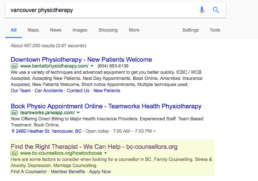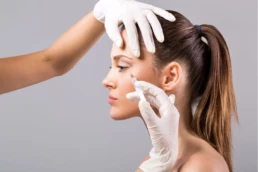Medspa Marketing
Medical Spa Marketing: a Digital Marketing Guide
(no-nonsense and field-tested!)
Medical Spa Marketing: a Digital Marketing Guide
(no-nonsense and field-tested!)
Medspa marketing refers to the strategies and tactics used by medspa businesses to promote their services, increase their visibility, and attract more clients.
Medspas, or medical spas, combine a medical clinic with a day spa that provides non-surgical aesthetic medical services under the supervision of a licensed physician.
The importance of medspa marketing cannot be overstated. Marketing plays a pivotal role in raising awareness about your brand and the services you offer. It is the best means to communicate with potential clients and inform them about what sets your medspa apart from the competition.
Perhaps what makes medspa marketing all the more vital is the high level of competition in the industry. With more and more medspas launching every day, setting your brand apart is crucial. Effective marketing strategies can help you do just that — by promoting the unique qualities and specific services of your medspa, and by highlighting your staff’s expertise and professionalism.

What is medspa digital marketing and why is it important?
Digital marketing is a crucial part of medspa marketing. With most customers researching online before booking a service, medspas need to have a robust, effective, and modern online presence. This includes a well-designed, responsive website, active profiles on social platforms, and a well-optimized online listing.
Content marketing is another important strategy in medspa marketing. This involves creating valuable, relevant content that can attract and engage your target audience. The content can be about the services you offer, tips for skincare, latest trends in aesthetics, etc.
Email marketing, i.e., sending regular newsletters and promotional offers to your subscriber list, can also be very effective. Emails can be personalized and targeted to specific groups within your audience, making this form of marketing highly efficient and profitable.
PRO TIP: Ensure digital marketing success by using the correct analytic tools and focusing on valuable metrics. For example, if phone calls are your main channel for client leads, set that up correctly as a conversion on your website.

Finally, relationship marketing can be valuable in the medspa business. Satisfied clients are often good ambassadors for your brand and can bring in more clients through word-of-mouth referrals.
In summary, medspa marketing is a broad and multifaceted area that requires time, effort, and resources. However, its importance justifies the investment. When done right, marketing can have a huge positive impact on your medspa’s success and profitability.
How to begin with medspa marketing?
Medspa marketing may seem overwhelming at first, especially for those who are new to it. The first step in starting with medspa marketing is to define clear objectives and goals. Start by asking what you hope to achieve through marketing. Is it to increase brand awareness? Attract more clients? Improve client loyalty and retention?
Once you know what your goals are, determine your target audience. Understand who your typical clients are — their age, gender, lifestyle, interests, and what they value most when choosing a medspa. This will help you tailor your marketing messages and strategies to meet these preferences and expectations.
Next, evaluate your competition. Understanding what other medspas in your area are offering, and how they’re marketing their services, can give you valuable insights and help you identify opportunities for differentiation.
When it comes to choosing the right marketing channels, a multi-channel approach is usually most effective. This could include a mix of digital marketing (website, SEO, working with a Facebook Ads Agency, email), content marketing, traditional marketing, and relationship marketing.
For content creation, consider hiring a professional copywriter or marketer who understands the medspa industry. They can create captivating, engaging content that speaks to your target audience.
Don’t forget to set a budget. Medspa marketing can come with substantial costs, from website development and SEO to social media advertising and email marketing software. It’s important to know how much you’re willing and able to spend before diving in.
Track your results meticulously. From the start, put systems and tools in place to monitor your progress. This will help you identify what’s working and what’s not, and make necessary adjustments along the way.
Finally, remember that medspa marketing is a long-term game. It might take time to see results, but patience and consistency are key to success. Keep testing, analyzing, and improving your strategies, and the results will follow.
PRO TIP: Evaluating your competitor’s campaigns means you don’t have to start from zero. Look what they are doing well, model and improve and take advantage of the readily available data modern digital marketing tools can provide.
What are the effective strategies for successful medspa marketing?
Effective medspa marketing requires a mix of multiple strategies, and understanding what works best for your specific business can help you develop a solid plan. Below are some of the most effective strategies.
1. Develop a Unique Selling Proposition (USP): A USP helps differentiate your medspa from competitors. It could be anything from innovative treatments, experienced staff, exceptional customer service, or a comfortable and luxurious environment.
2. Creating a Professional, User-friendly Website is Essential: Your website is your virtual storefront and often the first interaction potential clients will have with your medspa. Make it responsive across all devices, user-friendly, visually appealing, and ensure it provides all necessary information.
3. Optimize for Search Engines: SEO helps your website rank higher on search engine result pages. This increases your online visibility, making it easier for potential clients to find you. This involves keyword implementation, quality content, and a strong link profile.
4. Social Media Marketing Can Generate Leads: Utilizing social networks is a great way to reach and connect with your target audience. Share engaging content, promote your treatments, and respond promptly to queries and comments. Don’t forget to test Facebook Ads. Quality targeted ad creatives drive real business.
5. Leverage User-Generated Content (UGC): Request satisfied clients to share their experiences on social media, and don’t forget to repost or highlight the best UGC content on your platforms. This increases credibility and encourages others to try your services.
6. Email Marketing Stimulates Repeat Business: Collect email addresses from your website visitors, and use them to send newsletters, updates, and special offers directly to their inbox.
7. Run Special Offers and Promotions: Whether it’s a discount for first-time clients, loyalty programs, or seasonal offers, promotions can attract new clients and entice existing ones to try additional treatments.
8. Invest in Content Marketing: Create valuable and informative content about the treatments you offer, skincare advice, and latest industry developments. This not only attracts more traffic to your website but also establishes you as an expert in your field.
9. Paid Advertising Done Right Works: Paid campaigns on search engines or social media platforms can help you reach a larger audience and enhance your online visibility.
10. Tracking the Right Data: Finally, ensure you measure and track the effectiveness of your strategies. Use analytical tools to understand how well your efforts are converting into appointments and adjust your strategies as necessary.
Overall, for successful medspa marketing, it’s important to regularly review and update your strategies and stay current with the latest marketing trends and best practices.
How much should I invest in medspa marketing?

Determining how much to invest in medspa marketing depends on several factors including the size, location, and revenue of your business, as well as the industry’s competitive landscape. A general rule of thumb for small businesses is to allocate between 7-8% of your gross revenue to marketing.
As a starting point, you’ll want to establish a clear and realistic budget. This should include all aspects of marketing, including website development and maintenance, SEO, content creation, email marketing, social media advertising, and potentially hiring marketing professionals or marketing agencies.
Digital marketing should take a considerable proportion of your budget, as it is typically more cost-effective than traditional methods. Besides, it also allows for better targeting and tracking of ROI. Within digital marketing, you ought to allocate funds for website updates, advertising on platforms like Google and Facebook, and tools for email marketing and SEO.
Content marketing too should receive a good chunk of your budget, as it serves a dual purpose. It helps improve SEO (by attracting links and improving relevancy for search engines) and builds trust and credibility with potential clients.
Don’t forget offline marketing efforts such as print advertising, direct mail, and event sponsorship. While they can be harder to track in terms of ROI, they can still be effective in raising brand awareness, particularly in your local community.
Remember to set aside some budget for measurement and analysis too. Tools like Google Analytics, Facebook Insights, and various CRM systems can provide valuable insights into the effectiveness of your marketing efforts, informing future investment decisions.
Bear in mind that budgets should be flexible. Review your budget and actual spending regularly, and be ready to adjust as needed depending on what is working and what isn’t. Ideally, the more your business grows, the more should be your investment in marketing.
PRO TIP: Digital medical spa marketing requires an investment. It’s not magic and won’t bring you a 5000% return on your initial investment. If you’re smart and plan well, it’s the easiest marketing channel to get a healthy return on…and then build on to scale up.
How can I increase customer engagement in medspa marketing?
Customer engagement is pivotal in medspa marketing. The more engaged customers are, the more loyal they become to your business, leading to increased repeat visits and referrals. Below are some strategies for increasing customer engagement.
1. Offer personalized experiences: Personalization makes customers feel special and builds stronger relationships. Remember their names, preferences, last purchases, and tailor your services and marketing messages accordingly.
2. Develop a strong online presence: Regularly update your website and social media platforms with engaging content. Respond promptly to comments and queries, initiate discussions, and encourage clients to get involved.
3. Create a robust email marketing strategy: Send tailored emails based on customer behavior or interests. Regular newsletters, updates, and special offers make customers feel valued and keeps your medspa on top of their minds.
4. Ensure excellent customer service: Don’t make your interaction sales-oriented only. Show genuine concern for their well-being and satisfaction. Ask for feedback and act upon it.
5. Reward loyalty: Implement a loyalty program that provides exclusive benefits or discounts to frequent clients. This not only encourages repeat business but also makes clients feel appreciated.
6. Hold events or workshops: Hosting in-house events or workshops gives clients an opportunity to interact directly with your team, learn about your services, and engage with fellow clients.
7. Educate your customers: Share informative content about skin care, dietary advice, latest trends, etc. Engaging and helpful content will make your clients value your expertise and keep coming back for more.
8. Measure and adjust: Lastly, always measure your engagement levels. Use tools and metrics to assess the effectiveness of your strategies and refine them to maximize engagement.
To sum up, increasing customer engagement in medspa marketing involves offering personalized experiences, interacting regularly, rewarding loyalty, and continually measuring and improving engagement strategies.
What are the common challenges in medspa marketing and how to overcome them?

Medspa marketing comes with its own set of challenges. Understanding these challenges can help you formulate effective strategies to overcome them.
Standing Out in a Competitive Market: The medspa industry is highly competitive. Differentiating yourself can be a challenge. To overcome this, build a strong Unique Selling Proposition (USP). Regularly update your services portfolio, invest in training staff, and build an excellent customer service reputation.
Building a Strong Online Presence: Again, a strong online presence is crucial in today’s digital age. However, it can be challenging due to constant algorithm updates and rising competition for visibility. Stay updated with the latest SEO practices, regularly produce high-quality content, invest in digital advertising, and have an engaging social media presence.
Maintaining Customer Relationships: Building and maintaining customer relationships with frequent and meaningful interactions can be difficult. Implement CRM systems to keep track of all customer interactions. Personalize marketing communications and reward loyal customers.
Balancing Costs: Marketing can be expensive, but necessary. Striking the right balance can be tough. Develop a detailed marketing budget and stick to it. Keep track of all expenses and understand the ROI of each initiative.
Keeping Up with Trends: The aesthetics industry is constantly evolving, making it difficult to keep up. Regularly researching and learning about new trends, attending industry events, networking with other practitioners, and investing in continuous education and training can help.
Regulatory Compliance: Medspas must comply with specific laws and regulations regarding advertising medical and wellness services. Make sure to understand these laws thoroughly, and consult with a legal professional if needed.
In conclusion, although medspa marketing presents numerous challenges, understanding them can help you formulate effective strategies to overcome them and achieve marketing success.
How to measure the effectiveness of my medspa marketing strategies?
Measuring the effectiveness of your medspa marketing strategies is critical to understand what’s working and what needs improvement. It helps make data-driven decisions and ensures that your marketing budget is being used efficiently. Here are ways to measure effectiveness.
Website Analytics: Tools like Google Analytics can provide insights on traffic sources, demographics of visitors, time spent on site, bounce rates, and conversion rates.
Social Media Metrics: Most social media platforms provide analytics on reach, engagement, follower growth, and click-through rates. These can give a clear picture of how your social media efforts are performing.
Email Marketing Metrics: Key metrics include open rate, click-through rate, conversion rate, and unsubscribe rate. These can help gauge the effectiveness of your email blasts.
Online Reviews and Ratings: Online reviews and ratings are direct feedback from your clients and are significant indicators of your service quality. High ratings and positive reviews will signal your success, while negative ones spotlight areas for improvement.
Client Surveys: Ask clients to fill out surveys. Their responses will give valuable feedback on what they like and what they don’t, providing a clear understanding of areas where you can improve.
Conversion Rate: It’s the percentage of visitors who become your customers. A high conversion rate normally correlates to effective marketing strategies.
Customer Acquisition Cost (CAC): This refers to the amount spent on acquiring a new customer. By tracking this, you’ll know if your marketing is cost-effective.
Customer Lifetime Value (CLV): It’s the total revenue a single customer is expected to generate for your business. A high CLV often indicates successful retention efforts and quality customer service.
Finally, the most important part of measuring effectiveness is adjusting your strategies based on what the metrics reveal. If something isn’t performing as well as you’d hoped, don’t hesitate to adjust, test new methods, and constantly iterate until you find what’s most effective for your medspa.
What social platforms are best for medspa marketing?
There isn’t a one-size-fits-all answer to which social platforms are most effective for medspa marketing because the effectiveness of a platform can greatly vary depending on different factors such as your target audience, geographical location, and the nature of your service offerings. As such, it would perhaps be more helpful to say that what really matters is not as much the platform which you use, but rather how you use it.
Understanding how to leverage the platform effectively is crucial. Each social media platform has its own unique features and tools to facilitate engagement, client acquisition, and branding. For example, Instagram offers visually appealing posts and stories, while Facebook has advanced targeting features for advertisements. So, knowing the strengths and weaknesses of each platform enables you to tailor your content and advertising strategy more effectively.
Equally important is knowing what works best. This can be achieved through careful observation and monitoring of successful competitors, staying updated with latest social media trends, as well as experimenting with different kinds of content and marketing strategies.
Testing is another key aspect. Regular testing and adjusting of your social media strategies is crucial to identify what types of content, post timings, and advertising methods engage best with your audience. This may involve A/B testing or other analytical methods to refine your approach based on real, measurable results.
Moreover, measuring your success using the right metrics is vital. These metrics could include engagement rates, conversion rates, website traffic, and other key performance indicators (KPIs) relevant to your goals. Constantly monitoring these will help ascertain the efficacy of your social media efforts and guide future initiatives.
In conclusion, while some platforms may naturally lend themselves more advantageously to marketing a medspa due to their user demographics and functionality, the key to a successful social media marketing strategy lies more in understanding how to tap into the potential of these platforms effectively.
What future trends in medspa marketing should I prepare for?
1. Personalization: Personalization in marketing will continue to be critical in the future. Customers will expect a more tailored service and experience when visiting a medspa. This could mean personalized treatments, aftercare regimes, and even marketing messages. Tools like CRM software and data analysis will help tailor marketing approaches to individual customers, improving results and client satisfaction.
2. Virtual Reality (VR) and Augmented Reality (AR): As these technologies become more prevalent, they have wide-ranging applications in medspa marketing. For instance, you could use AR to give potential customers a virtual tour of your facilities or use VR to demonstrate the results of certain procedures.
3. Influencer Marketing: As social media continues to dominate the marketing landscape, the power of influencers is only likely to increase. Medspas can benefit from partnerships with influencers who can endorse their services and create content that reaches a wider audience.
4. Video Marketing: With the popularity of video content, it is becoming crucial in marketing strategies. Short, engaging video clips on social media platforms can effectively showcase treatments and services.
5. Telemedicine: While traditionally used for healthcare, telemedicine could play a significant role in consultations for medspa treatments. Online consultations can make it easier for customers to find the best treatment for their needs without an in-person visit, expanding the potential client base.
6. Artificial Intelligence (AI) and Chatbots: AI can help in predicting potential treatment outcomes, while chatbots can provide quick customer service, answer common queries, and even book appointments.
7. Mobile Marketing: With more people using smartphones, making your medspa mobile-friendly is vital. This could mean developing an app for bookings or ensuring your website is mobile-optimized.
8. Online Reviews and Reputation Management: Online reputation will continue to be vital for attracting new customers. Regularly monitoring and responding to reviews on platforms like Google and Yelp can help cultivate a positive image.
9. Content Marketing: Helpful and informative content that provides value to potential customers will continue to drive traffic, build brand reputation, and increase conversions. Blogs, guides, or even ebooks can establish your medspa as a leader in the industry.
Get more website traffic & leads with our proven approach to digital sales and marketing.
Get more website traffic & leads with our proven approach to digital sales and marketing.
Get more website traffic & leads with our proven approach to digital sales and marketing.
Get more website traffic & leads with our proven approach to digital sales and marketing.
4 Common PPC Mistakes Medical Practices Make
4 Common PPC Mistakes Medical Practices Make
Pay-per-click (PPC) advertising can be an effective and affordable way for a medical practice to attract new patients. But with so many elements to consider when launching a PPC ad campaign, it’s easy for inexperienced practice owners to make mistakes. Costly mistakes.
Here are four of the more common PPC advertising errors we run into with our healthcare clients.
Are you making any of them?
1. Not Monitoring your Campaigns Properly

If you can’t measure it, you can’t improve it. This is true in all areas of our lives and something most of us consider to be common sense. But as the old saying goes, “the problem with common sense is that it’s not so common.”
Conversion tracking is your PPC campaign’s oracle. Without conversion tracking in place, and running properly, you’ll be hard pressed to know what’s working, what needs fine-tuning, and what needs an overhaul.
Call-tracking not set up? Since most new patient enquiries come via the phone, it’s critically to know which campaigns are driving those calls. Call-tracking allows you to monitor and the keyword level. Granular, essential, and money-saving!
2. A Lack of Focus

If you don’t target your ads correctly, you’ll end up with the wrong visitors who just won’t generate revenue for your practice.
Match Type Misfire
Practices make this mistake frequently with keyword match types. Match types are often misunderstood and more often than not, keywords are too broad – which inevitably leads to ads showing up for irrelevant searches.
In the search below, you can see a typical example: in the 3rd position, therapy counselling is showing up for a popular physiotherapy search term. Obviously, when one is searching for a physiotherapist, the intent of the search query is to solve the problem of a physical ailment, not an emotional/mental health issue.

Adgroup Overload
Too many keywords in an adgroup is another place where practices bleed money. More is not always better, and this is especially true when you’re setting up your adgroups. Too many keywords per adgroup makes it almost impossible to “message match” with your copy and landing page.
Throw Everything at the Wall to See What Sticks
Because you’re not sure what’s really important to your potential patients (and you’re spending good money) – you include everything on your landing page. Every review that’s ever been written, every offer you have, anything and everything.
And this is confusing to the visitor that just clicked on your ad and now has to try to make sense of this mess. Nothing drives visitors away faster than confusion. Stick to one goal, one message, or one desired action per page.
3. Not Customizing Landing Pages to Specific Campaigns

This is widespread across a variety of industries, and something that drives PPC professionals into fits. But it is particularly common in healthcare.
Relevance matters. So, try to match your ad to a specific page as much as you can.
If your ad is aimed at women in the early stages of pregnancy, make sure there is a pregnant woman on your landing page…and/or, the same language (“Best San Diego OB-GYN”) that you use on your ad. Don’t send them to your general clinic page that lists the 10 other services you offer.
In other words, don’t create different ads with significantly different copy and send them to the same landing page.
Homepage Hang-Up
One of the biggest mistakes that AdWords beginners make is driving paid traffic to their homepage. This may be okay if this is a small part of a larger “awareness campaign,” but it’s generally a recipe for campaign underperformance.
Want to get new patients for a new procedure your clinic is offering? Create a specific campaign for that objective. Then, a specific corresponding landing page. A landing page dedicated to that objective is a huge part of maximizing the return you’ll see from your ad investment.
Keep in mind, visitors who click on ads and arrive on a landing page normally have a specific goal or intention in mind. So the most important thing you have to do, is instantly show relevance – by helping them achieve that goal.
Page Level Diagnosis
Here are some of the more obvious errors we see at the page level:
- Not aligning the CTA (call-to-action) and the contact form with the landing page copy.
- Too much information at the page.
- Asking too many different things of the visitor.
- Competing visual elements on the page.
- Poor copy.
4. Not Geo-targeting Effectively

Would someone drive 100 miles for your expertise? If you’re an orthopedic knee surgeon, that may be reasonable. A family dentist? Not likely, unless there are no other local options.
That’s not to say that you can’t add a reasonable radius. You can and it may be the best thing you can do depending on your specific location, the density of your area, and the number of similar providers in the area.
In fact, you can get very specific with your targeting, even by zip code – which can allow you to tailor messaging and speak to specific demographics.
Being mindful of how proximity influences our medical choices is something that needs to be considered and planned out at the campaign strategy level, as it has trickle down implications for much of your marketing campaigns.
PPC is not easy. If done wrong, you can burn through thousands of dollars. But if you target the right people, with the right expectations, and measure, test and iterate – you can make PPC an effective instrument in your medical marketing.
Get more website traffic & leads with our proven approach to digital sales and marketing.
Get more website traffic & leads with our proven approach to digital sales and marketing.
Get more website traffic & leads with our proven approach to digital sales and marketing.
Get more website traffic & leads with our proven approach to digital sales and marketing.
Dental Email Marketing to Increase Patient Flow
Dental Email Marketing to Increase Patient Flow
Achieving a 450% patient increase in November and December for a multi-location dental practice was a win for our client, and made everyone involved feel proud.
To be fair, by no means are we the only ones responsible for this increase in patient flow. This is an established practice, with talented internal teams that support marketing campaigns where it matters most – directly with their patients.
This particular campaign was strong because of the processes put in place to support it.
It is a repeatable, achievable strategy that any dental practice can accomplish, even at a smaller scale.
It’s All About Their Benefits

Wouldn’t it be great if all of your dental patients could actively plan out their check-ups and procedures throughout the year. They’d get the dental care they need, while at the same time, making the most of their own dental insurance plans.
Unfortunately, we’re all busy and sometimes our own dental care planning takes a back seat to soccer tournaments, vacation plans, and day-to-day life.
So how does a practice work to change this without coming across as self-serving?
It Started with a Survey

This annual campaign, called “Getting the Most out of your Dental Insurance” focused on patients’ awareness and understanding of their own benefits plan.
It began in July with an email marketing campaign to the entire patient list, promoting a short online survey created with the following focus points:
- We wanted to get patients asking themselves whether they take full advantage of their benefits – every calendar year.
- To generate awareness that unused benefits do not “roll over” into the next year.
- That paying insurance premiums and not using their benefits was the equivalent of paying their insurance provider for nothing.
- We also introduced the idea of larger treatments that could be split between years in order to maximize coverage.
Published Results

We gathered the data and produced a report to re-engage patients in a second email marketing campaign. We included comments gathered during the survey, as well as the top reasons people gave as excuses or reasons why they didn’t fully use their benefits.
- This allowed us to create some visual campaigns with memorable quotes.
- Stats that we could publish and promote online and offline.
- And a call-to-action that would be used throughout the remainder of the campaign.
Facebook Remarketing Campaign

We utilized content created throughout the campaign to gently remind patients about their “unused benefits” in a friendly and fun style – while they were on Facebook.
We retargeted using custom audiences: those patients who visited specific pages related to the awareness campaign.
An Increase in Planning for Larger Procedures

If we stopped here, this still would have been a successful campaign. But one of the key goals identified by the client, was to increase planning for larger procedures by the patient base that was most sensitive to pricing and payments.
They tagged client files on an ongoing basis that were potential candidates for more extensive dental treatments involving multiple visits.
This segmented email list was targeted with a 3rd email campaign, that noted the procedure discussed, and the options to split the treatment over the two calendar years.
Direct follow up by phone occurred within a week of the email campaign.
Misfirings
There can be a benefit to simply sending email reminders to clients about their expiring benefits. But this isn’t always true.
There are 3 elements that are important and help you make the most of this type of campaign:
1. Repetition
2. Timing
3. Tone – keeping this light and educational without being pushy or “salesy.”
As long as you implement the process appropriately and put in the work to get there, these kinds of results are achievable.
NOTE: Many extended health benefits include physiotherapy, chiropractors, massage therapy, acupuncture and much more. These are all healthcare practices that can utilize this same strategy.






